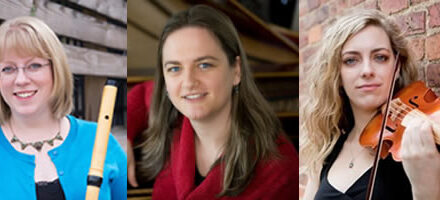The five consecutive concerts of the 2006 Magnolia Baroque Festival culminated June 24 in the Stevens Center with an all-Vivaldi program. Last year’s inaugural series ended with the ubiquitous Four Seasons. This program was much more imaginative, opening with four concertos and ending with a glorious and vital performance of the best known of the Red Priest’s Glorias, the Gloria in D, RV 589. All the instruments were of the period or reproductions. Some sense of the spirit of Vivaldi’s time was enhanced by using teenage girls from the Winston-Salem Children’s Chorus. For much of the composer’s life, he was employed as maestro di violino at the Pio Ospedale della Pietà, a facility for orphaned, abandoned, and indigent girls. Vivaldi oversaw their instruction in all instruments and voice. The lower end of the spectrum was taken by five-low voiced men and four tenors, anchored by festival founder Glenn Siebert.
Vivaldi’s all-orchestral concertos are rarely programmed so the Concerto in C, RV.116, was welcome. All the concertos were performed without a conductor. The precision of the ensemble playing was astonishing – comparable to a well prepared string quartet– and was all the more impressive in groupings as large as nineteen. Ingrid Matthews led the violins and the continuo consisted of John Lenti, theorbo, and ECU’s John O’Brien, harpsichord, along with two cellos and a double bass. The sections played as one, with crisp attacks, vital rhythms, and finely graduated dynamics. Several times in the concerto, the build up of dynamics approached that of the famous late 18th century “Mannheim roller.”
There was no “ill wind” about Michael McCraw’s seemingly effortless performance of Vivaldi’s Bassoon Concerto in D minor, RV.481. Despite rapid runs and sudden twists and turns, nothing fazed his flawless dexterity on the keys. His lower register was wonderfully pungent. The slow movement had an aria-like quality. O’Brien switched to a fine chamber organ for his portion of the continuo.
Solo violinists regrouped to form two antiphonal pairs for the Concerto in D, RV.549, for four violins. The soloists were Matthews and Julie Andrijeski on the left of the stage and Martha Perry and Jeanne Johnson on the right. The themes were taken up in turn by each soloist. The third movement has a showy solo that was effortlessly tossed off by Matthews. (As an example of the nationwide range of talent of the players, Andrijeski is a member of Chatham Baroque, a group CVNC has reviewed on the Piccolo Spoleto series.)
UNC’s Brent Wissick was joined by Elizabeth Reed for a spirited performance of the Concerto in g minor, RV.531, for two cellos. Their instruments have enough difference in timbres to provide contrast when appropriate while allowing for a fine blend when they were paired. The slow movement was like an arioso for two tenors. The rapid-fire finale displayed Wissick’s and Reed’s fine control of intonation and clean articulation.
Vivaldi’s Gloria in D, RV.589, has had numerous performances in the Triangle and Triad but this festival presentation was special. The male singers came from the N. C. School of the Arts. Siebert anchored the four tenors. A former Fletcher Opera Institute Don Giovanni , Krassen Karagiozov, was among the five baritones and basses. There were nine sopranos and nine altos, members of the Young Women’s Ensemble, a part of the Winston-Salem Children’s Chorus, which is directed by Barbara C. Beattie.
Every word of the Latin text was projected clearly and expressively by the choir and the two soloists, soprano Ah Hong and mezzo-soprano Mary Siebert. Siebert’s firm lower range provided a fine contrast with the soprano’s bright highs. The distribution of continuo duties was very imaginative with O’Brien switching between harpsichord and chamber organ while often being joined by theorbo, cellos, and double bass. Conductor Joseph Gascho led from a second harpsichord, used to accompany intimate solo vocal passages. The flawlessly played valveless trumpets, led by Barry Bauguess, were both brilliant and thrilling in the fast-paced opening and closing sections. Tempos were, on the whole, fast; there was no sentimental dragging in the slow movements. The large and enthusiastic audience demanded many curtain calls for the soloists. Bravo!











